What is Glaucoma?
A group of eye conditions that can cause blindness.
With all types of glaucoma, the nerve connecting the eye to the brain is damaged, usually due to high eye pressure.
The most common type of glaucoma (open-angle glaucoma) often has no symptoms other than slow vision loss. Angle-closure glaucoma, although rare, is a medical emergency and its symptoms include eye pain with nausea and sudden visual disturbance.
Treatment includes eye drops, medication and surgery.
Symptoms
Can have no symptoms, but people may experience:
- Blurred vision
- Distorted vision
- Vision loss
- Pain
- Watering
- Headache
- Redness
Main Cause of Glaucoma
- Your eye constantly makes aqueous humor. As new aqueous flows into your eye, the same amount should drain out. The fluid drains out through an area called the drainage angle. This process keeps pressure in the eye (called intraocular pressure or IOP) stable. But if the drainage angle is not working properly, fluid builds up. Pressure inside the eye rises, damaging the optic nerve.
- The optic nerve is made of more than a million tiny nerve fibers. It is like an electric cable made up of many small wires. As these nerve fibers die, you will develop blind spots in your vision. You may not notice these blind spots until most of your optic nerve fibers have died. If all of the fibers die, you will become blind.
Types of Glaucoma
There are several types of glaucoma. The two main types are open-angle and angle-closure.

Other types of Glaucoma
- Secondary Glaucoma.
- Pigmentary Glaucoma.
- Pseudoexfoliative Glaucoma.
- Traumatic Glaucoma.
- Neovascular Glaucoma.
- Irido Corneal Endothelial Syndrome (ICE)
- Uveitic Glaucoma
Can Glaucoma Be Stopped?
Glaucoma damage is permanent it cannot be reversed. But medicine and surgery help to stop further damage.
Medical Management of glaucoma:
Glaucoma is treated by lowering your eye pressure (intraocular pressure). Depending on your situation, your options may include prescription eyedrops, oral medications, laser treatment, surgery or a combination of any of these.
Trabeculectomy:
Trabeculectomy is a type of glaucoma surgery performed on the eye that creates a new pathway for fluid inside the eye to be drained. This is an outpatient procedure performed in the operating room. It is used to prevent worsening of vision loss due to glaucoma by lowering eye pressure.
Tonometry:
Tonometry is a test to measure the pressure inside your eyes. The test is used to screen for glaucoma. It is also used to measure how well glaucoma treatment is working.
Gonioscopy:
A procedure in which a gonioscope (special lens) is used to look at the front part of the eye between the cornea (the clear layer) and the iris (the colored part of the eye). Gonioscopy checks for blockages in the area where fluid drains out of the eye.
Gonioscopy is a painless exam uses to check a part of your eye called the drainage angle. This area is at the front of your eye between the iris and the cornea. It is where fluid called aqueous humor naturally drains out of your eye.
